Virtuosity and Spectacle
Carlo Blasis
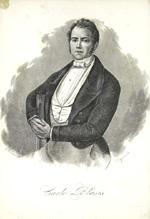
Portrait of Carlo Blasis
Dancer, choreographer, teacher, and writer,
Carlo Blasis was born in Naples in 1795, but grew up
in France, where he studied
with Jean Dauberval in Bordeaux
and made his Paris Opéra debut in 1817. In the decade or so that followed
he danced in Milan (appearing in ballets by Salvatore Viganò and Gaetano
Gioja), in Rome, Livorno, and Florence (partnering Amalia Brugnoli), in London,
where he staged a number of works at the King's Theatre, and in Venice, where
in 1831 he appeared as "first dancer" at the Teatro La Fenice. Although
Blasis choreographed ballets for La Scala and theaters all over Europe,
his works enjoyed only moderate success. Rather he found his true calling
as a ballet theorist and pedagogue. He published his first treatise,
Traîté élémentaire,
théorique et pratique de l'art de la danse in Milan
in 1820, and
The Code of Terpsichore in London in 1830, in addition to a number of later theoretical works
on pantomime, music, and the relationship of dance to the other arts.
Drawing on the French
and Italian traditions he had absorbed as a youth, Blasis codified ballet
technique as this existed on the eve of the Romantic revolution. He insisted
upon the necessity of daily class and laid out the order and progression
of exercises, intended to develop strength, grace, endurance, and lightness. In
1837, with his wife Annunciata Ramaccini, who taught the "class of perfection" in
mime, he became the director of la Scala's Imperial Academy of Dancing and
Pantomime, and in the next thirteen years transformed it into Europe's
foremost training venue. By the 1840s the success of his "method" was
evident in the constellation of stars emerging from his tutelage. Among
them were his seven "Pleiades"--Marietta Baderna, Pasquale Borri,
Augusta Dominichettis, Flora Fabbri, Amalia Ferraris, Sofia Fuoco, and Carolina
Granzini--and the numerous other dancers who studied with him at La Scala,
his private academy in Milan, and at the various theaters
in Europe and the Americas where
he worked. Brilliant technicians, they were particularly adept at turns
of all kinds and known for their aplomb, "steel" pointes, and speed. Blasis
both theorized and created the pedagogical basis for the scuola italiana,
or Italian school.
Technique, however,
was only one goal of the Blasis "method." As the ballerina Claudina
Cucchi wrote in her memoirs, he "insisted on his pupils learning and
reading for themselves...to acquire the most delicate culture and refinement. It
was not enough for him that they executed the pirouettes and entrechats well. He
wanted every movement to be stamped with that grace and loveliness that only
a serious training of the spirit and the intellect can give."
Carlo Blasis
Engraving after the portrait by Sir Thomas Lawrence,
[183-]. Cia Fornaroli Collection, Jerome Robbins Dance Division.
Flora Fabbri as Mazourka in Le Diable à Quatre (The
Devil to Pay)
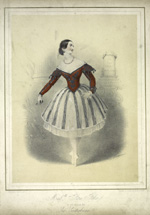
Flora Fabbri
Colored lithograph by John Brandard from a drawing
by James Child, London, 1846. Flora Fabbri was among the first of Blasis's "Pleiades" to
acquire international fame. She made her debut at the Teatro La Fenice in Venice
and danced throughout Italy during
the late 1830s and 1840s, often partnered by her French husband Louis (or
Luigi) Bretin. In 1845 she became a soloist at the Paris Opéra, appearing
in
La Sylphide,
Paquita, and the divertissements in Verdi's
opera
Jérusalem and Rossini's
Otello, while also dancing at London's Drury Lane Theatre in a version of Joseph Mazilier's
Le Diable à Quatre,
commemorated in this print. "Her dancing, all brio and fire," wrote
Blasis, "transports and surprises." Cia Fornaroli Collection,
Jerome Robbins Dance Division.
Marietta Baderna
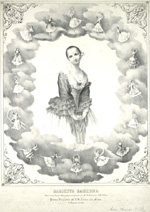 Marietta Baderna
Marietta Baderna
Lithograph from a drawing by Giuliani, [Milan,
1846?]. Marietta Baderna was another of the young stars trained at La Scala
by Blasis and launched by him on an international career while in her teens. In
fact, she was only sixteen, when this print, a tribute from her La Scala
admirers was made. A "first dancer," Baderna is depicted surrounded
by sixteen figures representing her in both classical and character roles. In
1847, Blasis took her to London,
where she played leading roles in his productions at Drury Lane. She later accompanied him to South America. Cia Fornaroli Collection, Jerome Robbins Dance Division.
Carolina Rosati in the title role of Coralia
Color lithograph by Emilien Desmaisons after
a drawing by Alexandre de Valentini, [London, 1847]. Trained by Carlo Blasis at his
private academy in Milan, Carolina Rosati belonged to
the first post-Romantic generation of virtuoso ballerinas that took Europe by storm. She had "toes of steel," speed, and lightness,
in addition to being an exceptionally fine actress. Rosati was the first
Medora in Joseph Mazilier's
Le Corsaire, producted at the Paris Opéra
in 1856, and the first Aspicia in Marius Petipa's
The Daughter of Pharaoh,
staged in St. Petersburg in 1862. In
this print she is depicted in the final underwater scene of Paul Taglioni's
Coralia,
which introduced her to London in 1847. Cia Fornaroli Collection, Jerome Robbins Dance Division.
Amalia Ferraris
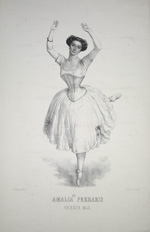
Amalia Ferraris
Lithograph by B. Marcovich, Vicenza,
[1853]. Another teenaged prodigy trained by Carlo Blasis at his private
academy in Milan, Amalia Ferraris
made her debut as
prima ballerina di mezzo carattere (or demi-caractère)
at La Scala in 1841 at the age of thirteen, dancing in Filippo Taglioni's
La
Sylphide. In the years that followed she danced all over Italy, while beginning to spread her wings abroad. From
1856 to 1863 she was the star of the Paris Opéra, leading the casts of Joseph
Mazilier's
Les Elfes (The Elfs) (1856)
Marco Spada, ou la Fille
du bandit (Marco Spada, or The Daughter of the Bandit) (1857), Lucien
Petipa's
Sacountala (1858), and Pasquale Borri's
L'Etoile de Messine (The
Star of Messina) (1861). "What is to be said about Mme Ferraris?" asked
Théophile Gautier in his review of
Sacountala. "She danced her
five
pas with lightness, gentleness and an unimaginable suppleness. Light
as a dove's feather when she rises, and firm as an arrow point on landing,
she preserves the chaste and voluptuous grace of Sacountala." Cia Fornaroli
Collection, Jerome Robbins Dance Division.
Caterina Beretta as Autumn in I Vespri
Siciliani
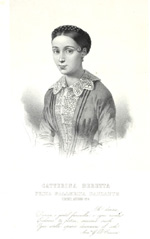
Caterina Beretta
Lithograph by Destouches, Paris,
[1855]. Trained at La Scala but as a student of Auguste Hus, Caterina Beretta
was not only one of the most celebrated Italian dancers of her day, but also
a highly respected teacher. She made her debut as a principal dancer at
La Scala and the Paris Opéra while still a teen, amazing audiences with her
speed, elasticity, precision, and strength. In 1855, at the age of fifteen,
she danced the role of Autumn in the divertissement choreographed by Lucien
Petipa in Giuseppe Verdi's opera
I Vespri Siciliani, a creation memorialized
in this print. In the years that followed, she appeared regularly at the
Teatro Regio in Turin, as well as dancing at La Scala,
the Teatro La Fenice in Venice, and the Teatro Pagliano
in Florence. In Venice in 1859,
during a performance of Pasquale Borri's
Gabriella la Fioraia (Gabriella
the Flower Girl), she pinned red and green flowers on her white costume--the
colors of the Italian independence movement--a political gesture that incited
a reaction from the Austrian police. In 1879, after working as a ballet
mistress in St. Petersburg, she opened a highly successful
school in Milan. Among her students
were Pierina Legnani, Olga Preobrajenska, Anna Pavlova, Vera Trefilova, and
Tamara Karsavina. Cia Fornaroli Collection, Jerome Robbins Dance Division.
Claudina Cucchi
Lithograph by Eduard Kaiser, Vienna,
[1858]. Encouraged at the age of six to take up dancing by the ballerina
Sofia Fuoco, Claudina Cucchi studied at the La Scala school under Carlo Blasis
and Auguste Hus, receiving as an
allieva emerita--or "distinguished
student"--an important role in Giuseppe Rota's
Un Fallo (The
Fault) at La Scala in 1853. She was soon snapped up by the Paris Opéra,
where she made her debut as Spring in
I Vespri Siciliani (1855), and
the following year created the role of Gulnare (to Carolina Rosati's Medora
and Domenico Segarelli's Conrad) in
Le Corsaire (1856). From 1858
to 1868 Cucchi danced as
prima ballerina at the Kärntnertor Theater
in Vienna, appearing in ballets by Pasquale Borri, Giovanni Casati, Paul
Taglioni, Giuseppe Rota, and Antonio Pallerini. She toured throughout Central
Europe and Italy; she
also danced briefly in Russia,
where Marius Petipa revived
Esmeralda for her, and in Cairo,
before ending her career in Rome
in 1874. Her memoir,
Venti anni di palcoscenico (Twenty Years on
Stage), was published in Rome in 1904. Cia Fornaroli Collection, Jerome Robbins Dance Division.
Carolina Pochini
Lithograph by Bignoli, Milan,
[1855]. Trained by her aunt Carolina Filippini, then by Carlo Blasis at
La Scala, Carolina Pochini made her debut in Bergamo
during the 1849-1850 season at the age of thirteen. She danced all over Italy,
but except for brief engagements in Vienna and London, confined her career to her native country. She
had a long relationship with La Scala, where she appeared in works by Giuseppe Rota (La Giocoliera [The Woman Juggler]), Gioacchino Coluzzi,
Paul Taglioni (Satanella and Electra), and her husband Pasquale
Borri, whom she married in 1860. Of medium stature, with extremely small
feet and strong limbs, Pochini had a sunny personality that made her one
of the brightest stars of the La Scala firmament. Jerome Robbins Dance Division.
Amina Boschetti
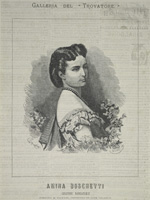
Amina Boschetti
Lithograph by Luigi de Crescenzo, [185-?]. Discovered
as a child by Marie Taglioni, Amina Boschetti studied with Carlo Blasis and
made her debut as prima ballerina assoluta at Milan's Teatro Re at the age of twelve. A year later she signed a
two-year contract with the choreographer and impresario Domenico Ronzani,
appearing with his company in Barcelona, Trieste, Florence,
and Vienna. She subsequently toured throughout Italy and appeared for several seasons in London. In 1864 she made her debut at the Paris
Opéra in Giuseppe Rota's
La Maschera, ou les Nuits de Venise (The
Mask, or Venetian Nights), astonishing audiences with her turns on full pointe
and her astonishing elevation in jumps. With her vivid mime and emphasis
on tours de force, she was a distinctly Italian dancer, and this, along with
her stockiness, did not sit well with French critics. She returned to Italy, where she remained a huge favorite, dancing
until the 1870s. Cia Fornaroli Collection, Jerome Robbins Dance Division.
La ballerina del Carignano gira con tanta
facilità, che qualche ingenuo crede perfino che il suo piede sia guidato
da qualche macchina nascosta sotto il palco scenico (The ballerina
of the Carignano [Theater] turns with such ease that a simpleton would
think that her foot was guided by a machine hidden under the stage)
Clipping from the Milan-based theatrical weekly, Il
Trovatore, [ca. 1858]. This caricature, which depicts a man operating
a turning apparatus under the stage during a performance, is a comment
on Amina Boschetti's remarkable ability to turn. Cia Fornaroli Collection,
Jerome Robbins Dance Division.
Giovannina King
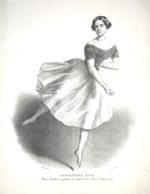
Giovannina King
Lithograph by Somariva from a drawing by Roberto
Focosi, Milan, [1844?]. Giovannina King received her early training from
Pietro Hus in Naples, her birthplace, before studying with Carlo Blasis in
Milan. In 1841 she made her debut at La Scala as
prima ballerina,
appearing in Antonio Cortesi's
L'ebrea di Toledo (The Jewish Woman
of Toledo). The following year, billed as "First French Dancer," she
appeared in Filippo Taglioni's
La Sylphide, a testament to the classical
style evident in this print. Unlike many Blasis protegées, King spent most
of her career in Italy, dancing with great success in Rome, Milan, and elsewhere. Cia
Fornaroli Collection. Jerome Robbins Dance Division.
Publications of Carlo Blasis
Traîté élémentaire, théorique et pratique de l'art de la danse, contenant
les développemens, et les démonstrations des principes généraux et particuliers,
qui doivent guider le danseur (Elementary theoretical and practical
treatise on the art of the dance, containing its development, and demonstrations
of the general and particular principles that should guide the dancer).Milan,
1820. Cia Fornaroli Collection, Jerome Robbins Dance Division.
The Code of Terpsichore. The art of dancing: comprising its theory
and practice and a history of its rise and progress, from the earliest
times: intended as well for the instruction of amateurs as the use of
professional persons. Trans. R. Barton.London, 1830. Jerome Robbins
Dance Division.
Lezioni di ballo giusto l'uso delle civili conversazioni (Lessons
in dancing correctly [and] the practice of civil conversation).Milan,
1830.
The Young Lady's Book: A Manual of Elegant Recreations, Exercises,
and Pursuits. 2nd ed.London, 1829. Blasis wrote the chapters
on Music and Dancing. Private collection (New York).
Saggi e prospetto del trattato generale di pantomima naturale e di pantomima
teatrale fondato sui principi della fisica e della geometria e dedotto
dagli elementi del disegno e del bello ideale (An essay and prospectus
for a general treatise on natural and theatrical pantomime founded on the
principles of physics and geometry and deduced from the elements of design
and ideal beauty).Milan, 1841. Cia Fornaroli Collection, Jerome Robbins
Dance Division.
Delle composizioni coreografiche e delle opere letterarie di Carlo Blasis. Coll'aggiunta
delle testimonianze di varii scrittori e di una dissertazione inedita sovra
le passioni ed il genio (On the choreographic compositions and literary
works of Carlo Blasis, with testimonies by diverse authors and an unpublished
dissertation on the passions and genius).Milan, 1854. Cia Fornaroli
Collection, Jerome Robbins Dance Division.